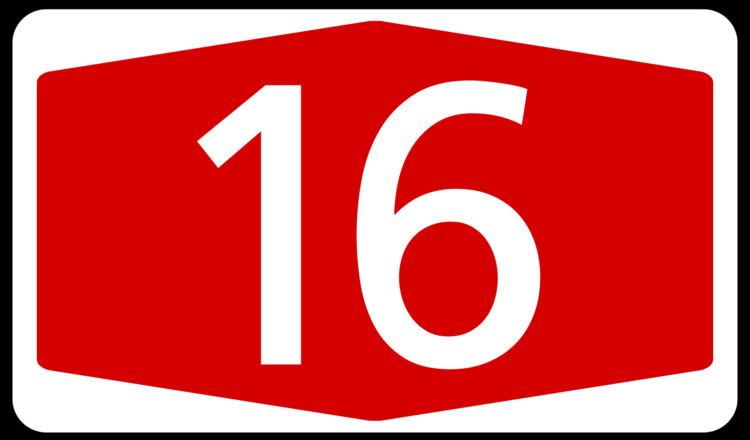Length: 84 km (52 mi) | ||
 | ||
The A16, a motorway in north-central Switzerland, is a divided freeway connecting the border to France to the A5 motorway, 84 kilometres (52 mi) to the south on the Swiss plateau.
Contents
The A16 motorway is a long, winding corridor that crosses the Jura Mountains from the Canton of Jura through part of the Bernese Jura area, to the flat part of the canton of Berne on the Swiss plateau. Therefore it is called Transjurane. It is congruent with the National Highway N16 and following its anticipated completion around 2020-2030, it will connect the French motorway network with the rest of the Swiss national road network. The extension provides for both four-lane standard (highway) and two-lane sections of "express roads" (Autostrasse). At present (2014), there are approximately 71 km (84%) of roadway in operation, other sections are under construction or are in planning.
History
The A16 starts at Boncourt in the Ajoie at the border between Switzerland and France. It runs south across the Ajoie plateau to Porrentruy, where it veers to the east. It crosses the northern Jura chains in Saint-Ursanne through two long tunnels, and reaches Glovelier, on the plateau of Delémont. After bypassing that city, the A16 turns south again, and follows the course of the Birse via Moutier and Court until Tavannes. Upon crossing Col de Pierre Pertuis through tunnels, the A16 follows the valley of the Suze (German:Schüss). It divides itself into a double lane road with separate downhill and uphill traffic on either side of the gorge of Taubenloch. It then reaches, the level of the Swiss plateau east of Biel/Bienne, connecting to the A5.
Status of construction
The following sections are in operation:
The following sections are under construction:
Because of the current financial constraints, the Swiss Federal Government can postpone most of the works on new sections. The connection of the A16 to the A36 motorway in France (Mulhouse - Dijon) between Montbéliard and Belfort is to be completed within a time horizon of 2025-2030.
Costs
Along its course, the A16 has many engineering structures, mainly tunnels but also some bridges. Therefore, the A16 is one of the most expensive road projects in Switzerland. For the whole line, a total cost of 5.6 billion Swiss francs is estimated.
Tunnels
Because of the difficult terrain in the area of the Jura Mountains, the construction of numerous tunnels is necessary to pass underneath the various Jura chains. The main tunnels (from north to south) with a length of more than 1 kilometre (0.62 mi) are:
There are 16 more tunnels that are less than 1 kilometre (0.62 mi) in length and were partly created in open pits. Some tunnels are, or have been, built to protect the residents of nearby villages and hamlets from the noise emissions.
History
The A16 was not one from the start to the national motorway network in Switzerland, although there were initial projects of Jura rapid-traverse between Biel and Belfort, as early as 1964. The inclusion of the A16 in the plan of the national road network came in 1984, after the population had approved construction in the Canton of Jura, with a large majority (71%). The highway should be the favored new project of the Jura and the Ajoie. The efficient transport corridor is to ensure, after completion, a much faster connection to the rest of Switzerland. Flora Ruchat-Roncati and Renato Salvi of ETH Zurich won the competition to design the highway in 1988.
Even after entering the national motorway network, there was the part of environmentalists strong opposition to the project. In the context of the so-called Clover Initiative, the construction of the A16 should be submitted to the entire Swiss population to vote. Due to the high acceptance of the project in the affected regions, the request was withdrawn before a vote on other controversial motorway cuts (in April 1990).
Paleontology
During the construction work on the A16, in the vicinity of Courtedoux, workers found a slab with about 500 footprints of dinosaurs, which used to live in the area about 150 million years ago.
